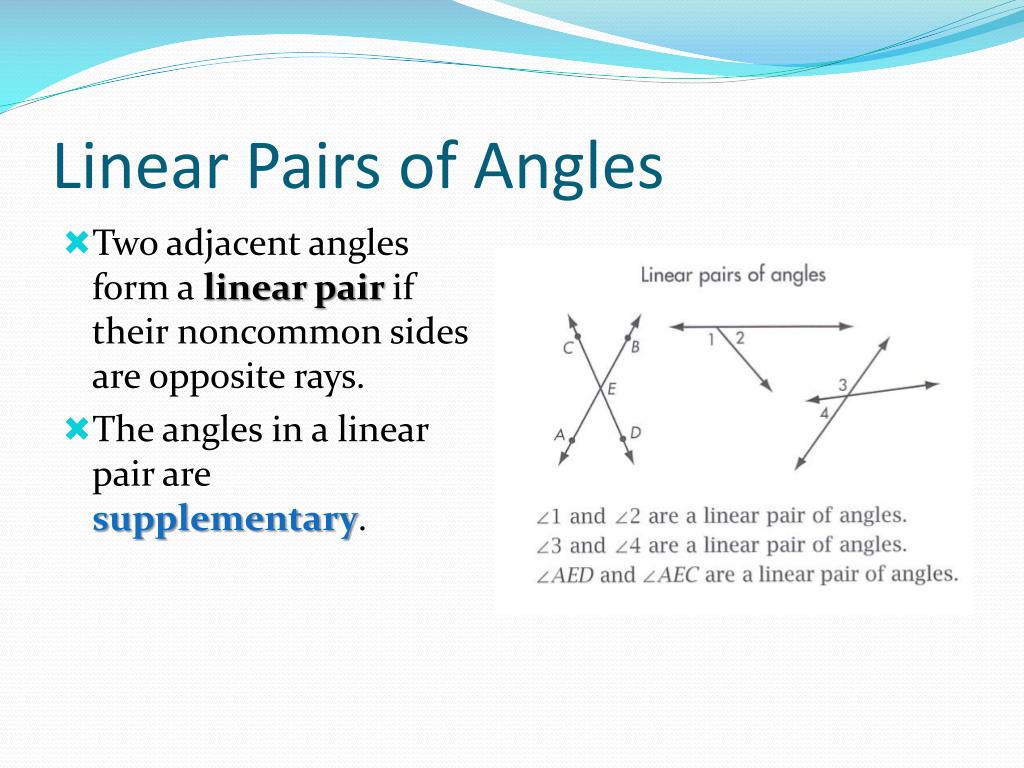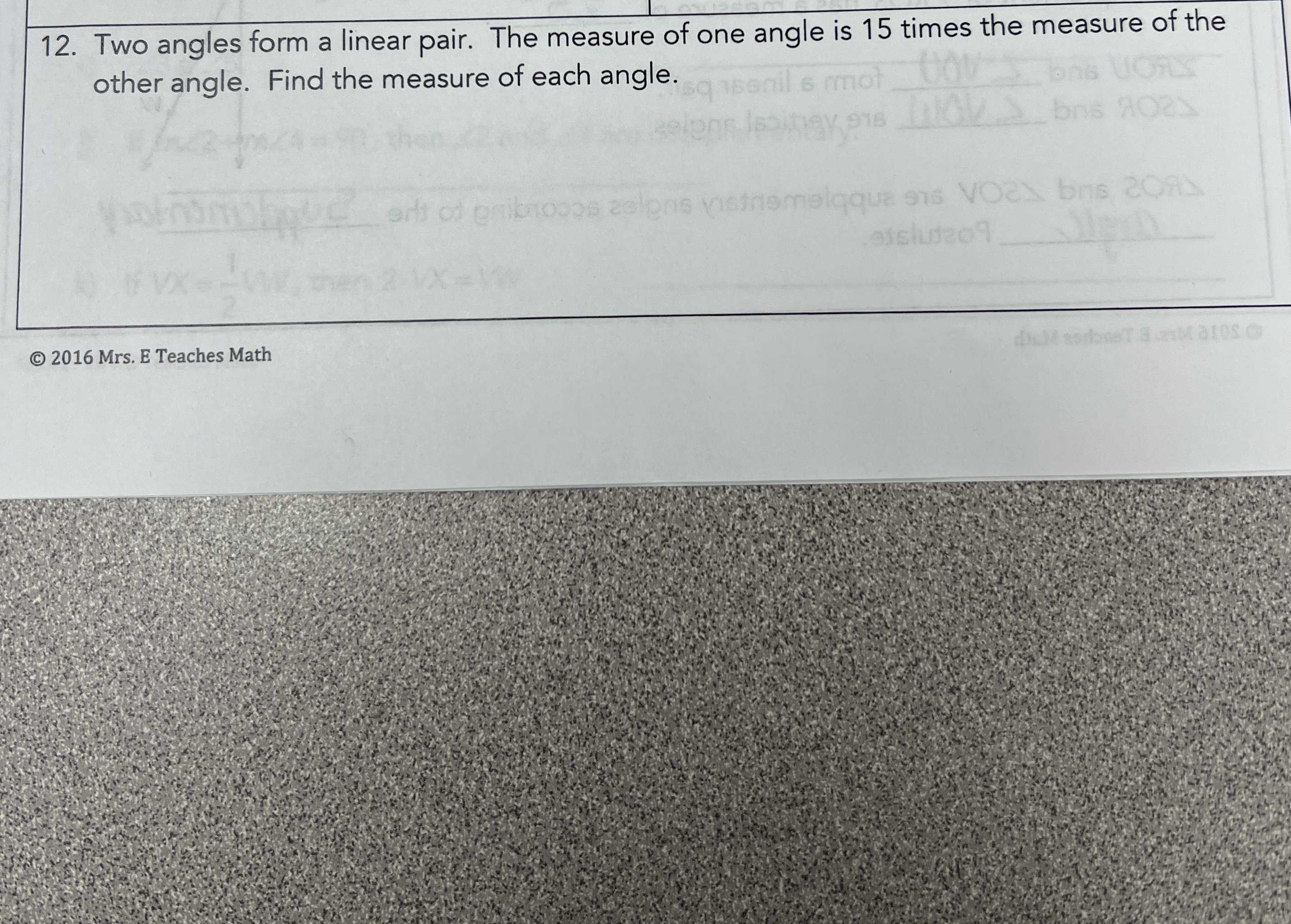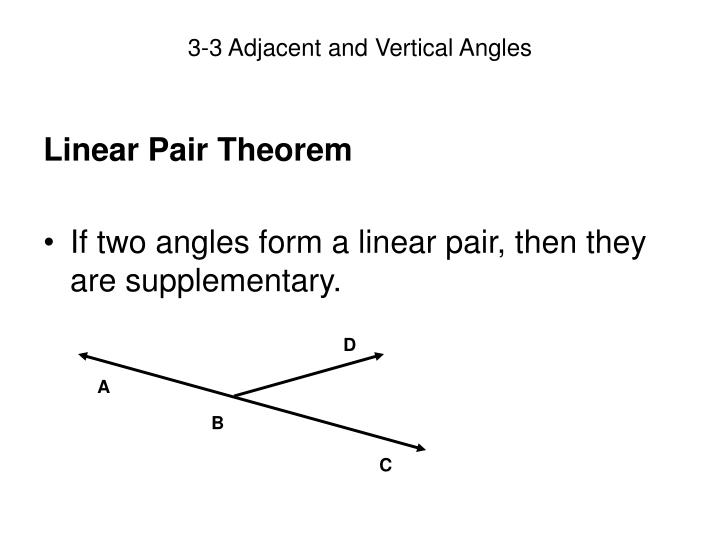Two Angles That Form A Linear Pair
Two Angles That Form A Linear Pair - Supplementary angles are two angles whose same is 180^o linear. (a) 50 ° + 40 ° = 90 °. But, all linear pairs are supplementary. Web not all supplementary angle form a linear pair. In the given diagram, o a and o b are. In the figure, ∠ 1 and ∠ 2 are supplementary by the. A linear pair are two angles that makes a line. Web however, just because two angles are supplementary does not mean they form a linear pair. A line is 180 degrees. If the two angles form a linear pair, then the sum of the two angles equals 180 degrees.
Two angles are said to form a linear pair if they add up to 180 degrees. The sum of linear pairs is 180°. It should be noted that all linear pairs are supplementary because. Web there are some properties of linear pair of angles and they are listed below: Web up to 6% cash back the supplement postulate states that if two angles form a linear pair , then they are supplementary. Since the sum of angles is not equal to 90 °, the angles 50 ° and 40 ° do. Web up to 6% cash back a linear pair is a pair of adjacent angles formed when two lines intersect. Web the two angles make a linear pair, so the sum of measures of the two angles is 180°\text{\textdegree}°. This fact leads to a wide range of properties and applications. The steps to using this postulate are very.
In the figure, ∠ 1 and ∠ 2 form a linear pair. Web first we need to define what is a linear pair? Supplementary angles are two angles whose same is 180^o linear. This fact leads to a wide range of properties and applications. Linear pairs of angles are also referred to as supplementary. The sum of linear pairs is 180°. But, all linear pairs are supplementary. If the two angles form a linear pair, then the sum of the two angles equals 180 degrees. Web the linear pair postulate says if two angles form a linear pair, then the measures of the angles add up to 180°. Since the sum of angles is not equal to 90 °, the angles 50 ° and 40 ° do.
Name two angles that form a linear pair.
Two angles are said to form a linear pair if they add up to 180 degrees. Web first we need to define what is a linear pair? So do ∠ 2 and ∠ 3 , ∠ 3 and ∠ 4 , and. We now have an equation in two unknowns. Web linear pair of angles are two angles that form.
Definition and Examples of Linear Pairs YouTube
So that means <1 + <2 =180 but let’s call those. Supplementary angles are two angles whose same is 180^o linear. A linear pair are two angles that makes a line. Web when two lines intersect each other, the adjacent angles make a linear pair. Web not all supplementary angle form a linear pair.
📈In which diagram do angles 1 and 2 form a linear pair?
Linear pairs of angles are also referred to as supplementary. A line is 180 degrees. In the given diagram, o a and o b are. But, all linear pairs are supplementary. Web linear pair of angles are two angles that form a straight angle (angle measuring 180 degrees).
PPT Geometry Review Angles and Parallel Lines PowerPoint Presentation
A linear pair are two angles that makes a line. In the given diagram, o a and o b are. Web up to 6% cash back the supplement postulate states that if two angles form a linear pair , then they are supplementary. Web however, just because two angles are supplementary does not mean they form a linear pair. A.
The two angles below form a linear pair, and the expressions are
So do ∠ 2 and ∠ 3 , ∠ 3 and ∠ 4 , and. Web not all supplementary angle form a linear pair. Web there are some properties of linear pair of angles and they are listed below: It should be noted that all linear pairs are supplementary because. A line is 180 degrees.
Two angles form a linear pair. The measure of one CameraMath
If the two angles form a linear pair, then the sum of the two angles equals 180 degrees. So that means <1 + <2 =180 but let’s call those. This fact leads to a wide range of properties and applications. Supplementary angles are two angles whose same is 180^o linear. But, all linear pairs are supplementary.
Linear Pair lines and angles This postulate is sometimes call the
Supplementary angles are two angles whose same is 180^o linear. Web not all supplementary angle form a linear pair. But, all linear pairs are supplementary. In the figure, ∠ 1 and ∠ 2 form a linear pair. Web the linear pair postulate says if two angles form a linear pair, then the measures of the angles add up to 180°.
PPT 33 Adjacent and Vertical Angles PowerPoint Presentation ID6953038
In the figure, ∠ 1 and ∠ 2 form a linear pair. This fact leads to a wide range of properties and applications. Since the sum of angles is not equal to 90 °, the angles 50 ° and 40 ° do. A line is 180 degrees. The sum of two angles in the linear pair is always 180 degrees.
Linear pair
Two angles are said to form a linear pair if they add up to 180 degrees. Linear pairs of angles are also referred to as supplementary. Since the sum of angles is not equal to 90 °, the angles 50 ° and 40 ° do. Web there are some properties of linear pair of angles and they are listed below:.
Which statement is true about this argument? Premises If two angles
Web the two angles make a linear pair, so the sum of measures of the two angles is 180°\text{\textdegree}°. A line is 180 degrees. So do ∠ 2 and ∠ 3 , ∠ 3 and ∠ 4 , and. A linear pair are two angles that makes a line. The sum of linear pairs is 180°.
So Do ∠ 2 And ∠ 3 , ∠ 3 And ∠ 4 , And.
A line is 180 degrees. Web the two angles make a linear pair, so the sum of measures of the two angles is 180°\text{\textdegree}°. Web up to 6% cash back the supplement postulate states that if two angles form a linear pair , then they are supplementary. Two angles are said to form a linear pair if they add up to 180 degrees.
It Should Be Noted That All Linear Pairs Are Supplementary Because.
In the figure, ∠ 1 and ∠ 2 form a linear pair. So that means <1 + <2 =180 but let’s call those. A linear pair are two angles that makes a line. The sum of linear pairs is 180°.
Web Not All Supplementary Angle Form A Linear Pair.
Web the linear pair postulate says if two angles form a linear pair, then the measures of the angles add up to 180°. Linear pairs of angles are also referred to as supplementary. In the figure, ∠ 1 and ∠ 2 are supplementary by the. Since the sum of angles is not equal to 90 °, the angles 50 ° and 40 ° do.
If The Two Angles Form A Linear Pair, Then The Sum Of The Two Angles Equals 180 Degrees.
The sum of two angles in the linear pair is always 180 degrees. Web up to 6% cash back a linear pair is a pair of adjacent angles formed when two lines intersect. Web however, just because two angles are supplementary does not mean they form a linear pair. Web first we need to define what is a linear pair?









